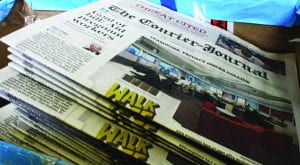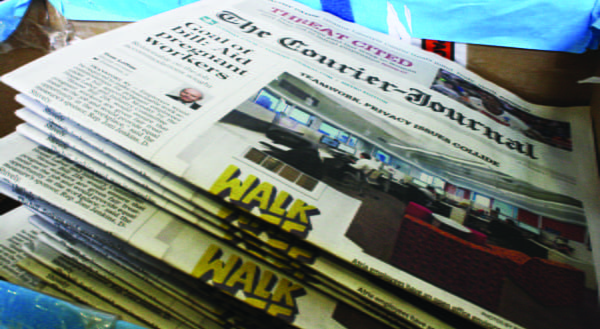BY IRINI BROM – CENTO WRITER
The Cento printed its very last paper issue ever two weeks ago. If you wish to read The Cento today, you can find it online on The Cento’s website through the link on the Centre website or by simply googling, “The Cento.” Even this very article will only be accessible online to those who wish to find it. It’s not just The Cento that’s making changes like this to its publications either. Everything from complete textbooks for classes to shopping receipts can be found starting at your home screen these days. However, is this change for the better, or are we headed down a slippery slope that ends with us answering to machines that have grown to have minds of their own?

The Cento Editor-in-Chief Sarah Cornett discusses why it was time to move to digital publication for this particular newspaper.
“We made the decision [to go digital] because of a lot of different factors. First of all, a print publication is a lot of additional work and stress and is incredibly expensive to produce. In my opinion, though, a print publication is still worth it as long as you have a strong print reader base. However, with the start of our new website this year, our print circulation has gone down considerably. We realized though that our web traffic has been increasing steadily, so it’s not that our overall readership is down, just our print readership. With all of those facts in mind it seemed like the right decision to go digital,” Cornett said.
And is it working out? Have there been any major kinks along the way that made the staff regret this big decision? Cornett says no.
“The transition has actually gone really well. Of course there is always going to be a bit of a learning curve with things like this and we completely changed the schedule and order of doing things, but everyone on staff has done an excellent job of communicating with each other to ensure that we stay on track with our deadlines.”
So it seems that going digital is working out for the Cento so far, but what about other forms of digital data that replaced printed material? Centre’s Head of Reference and Instruction at the Grace Doherty Library Carrie Frey talks about all things digital here in Centre’s library, ready for students to use at their will.
“The library holds over 40,000 different journal titles in our electronic databases. We also have a collection of electronic books available. Our Oxford Reference Collection showcases 332 different reference titles and these can be searched from one tab on the library homepage, twenty-four hours a day. Some of our electronic holdings wax and wane as journal titles are picked up or dropped by databases we subscribe to, such as JSTOR and Academic Search Complete. The benefit here is obviously access to more information [as well as] physical space constraints. Offering reference works and journal articles online, if these materials are indexed well, is a huge positive in terms of time and space savings.”
So is switching to digital really better? Do the students here,and all over the country, really need to get ready to retire the printed book forever and embrace a “one click fits all” kind of mentality? Not according to Frey.
“While online journals and reference sources see a great amount of use, we do not have good statistics for use of our ebook collections,” Frey said.
Frey recalls a talk with the bookstore supervisor and the student she met expressed their preference for their learning materials, most importantly textbooks for classes, in printed form. The most often given reason is that the physical act of highlighting, underlining, and writing in margins helps with retention and learning. Frey found that materials used on Kindles and other e-readers are more commonly novels and other popular materials. However, Frey recognizes that these readers still maintain features such as technological imitated page turning that are a nod to the printed reading experiences. “Another downside of digital archiving of information is the huge expense of the databases used to access materials. The library pays these exorbitant fees so that our patrons can have access, but those members of our communities who do not have access to technology obviously suffer as they are prevented from having access to information that requires subscription pricing” Frey said.
It seems then that even digital data is expensive and hard to maintain, which makes the argument a little less clear cut. It seems that there are valid pros and cons to using either form of information gathering. If we had to choose one though, which way of accessing information is the “best” overall?
“Truly, it depends on the information need, the user need, and the quality of the information provided in each instance,” Frey said. “In my humble opinion, accessing articles and reference materials online make for an easier user experience and ones that allow for a great return on the time invested. I believe that archival physical materials must be protected and maintained as much as possible to protect the historical records of place and community. I still prefer reading a hard copy book, for the tactile and more complete experience, but I do not have room to house all of the books I want to read, so I appreciate my Kindle very much. Some of the restrictions surrounding digital formats may be resolved in the next several years: access, subscription pricing, ownership, but even at that time I believe print still has a place and a purpose. For example, children’s books and art books, with their beautiful illustrations, are best printed. A good combination of print and digital makes for the best user experience and the most balanced learning environment in a library.”
